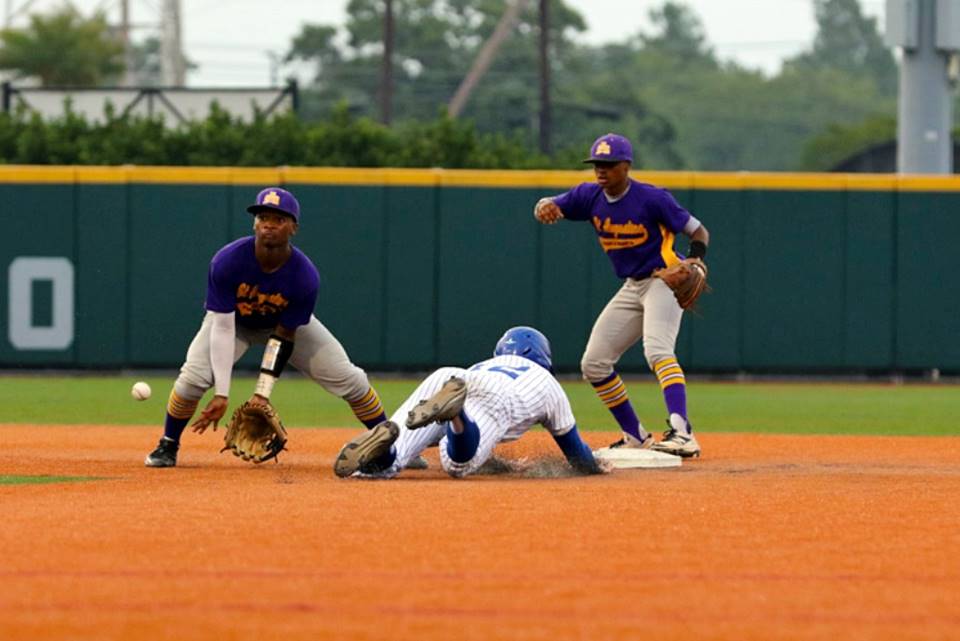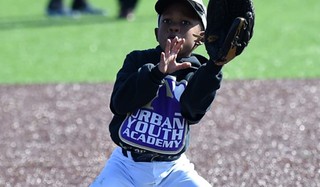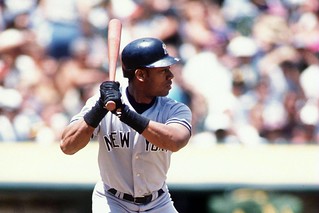African-American interest in baseball showing signs of life in New Orleans area high schools

Baseball is a great game. It happens to be the sport I loved most as a youngster and is one I continue to love and follow as an adult.
Jackie Robinson knew that as much as anyone, paving the way for inclusiveness in the game, opening doors for African-Americans. It was a daunting task and one he handled with tremendous dignity.
April 15 is Jackie Robinson Day around Major League Baseball, with everyone wearing the No. 42 which Robinson made famous.
If he were alive, Robinson would no doubt be disappointed with the lack of African-Americans playing the game at the Major League and even the Minor League level, much less on the college and high school levels.
Of the major sports, the game produces the longest careers and affords its players at the highest level the most income, based clearly on the number of games played annually.
Those facts should be enough for youngsters to become interested in the game.
As in all cases, interest and love of the game starts at a young age.
For the most part, African-Americans have not been interested in or in love with the game in the New Orleans area for several years.
Many factors can be cited, including poor playground facilities, no encouragement and the rapid, rising interest in football and basketball in the African-American community over the last three to four decades.
While predominantly African-American schools and other schools with a substantial number of African-American players continue to win and win big in football and basketball, no such school has won or even come close to winning an LHSAA state championship in baseball over the last 25 years.
In 1990 and 1992, East St. John won the state championship at the highest level of competition, winning 4A in 1990 and 5A in 1992, led by Armond Anderson, Calvin Lee, Courtney Mitchell, Darrel Nicholas and Harold Williams and Leroy Williams. The Wildcats defeated traditional powers in Archbishop Rummel in 1990 and Catholic of Baton Rouge in 1992 in the title games.
When you consider the small size of NBA rosters, the goal of reaching that level in the great game of basketball is very challenging. When you ponder how good you have to be in football to reach the NFL and the knowledge of what concussions have done to many over the years, baseball becomes an even more attractive option.
In the African-American community, baseball is often a long way from even a thought process, much less a consideration.
The numbers do not lie.
It is not hard to recite the name of outstanding, even great African-American baseball. Robinson is certainly one to mention.
I think of Hank Aaron, Willie Mays, Ken Griffey, Jr., Barry Bonds, Willie McCovey, Dick Allen, Ozzie Smith, Eddie Murray, Ernie Banks, Bobby Bonilla, Joe Morgan, George Foster, Derek Jeter, Dwight Gooden, J.R. Richard, Don Newcombe, Lee Smith, Roy Campanella, Andre Dawson, Willie Stargell, Billy Williams, Lou Brock, Darryl Strawberry, Tony Gwynn, Tim Raines, Barry Larkin, Derek Jeter, Lou Whitaker, Frank Thomas, Rod Carew, Fergie Jenkins, Bob Gibson, Frank Robinson, Rickey Henderson and even Albert Belle.
Satchel Paige and Josh Gibson were brilliant and deserved opportunities in the Major Leagues, along with many others who were denied the chance to do so.
That is some list to think about. You could build a brilliant team for life from such amazing talent.
Last year, U.S. News and World Report stated that MLB has spent more than $30 million on the Reviving Baseball in Inner Cities program in an effort to interest and engage more African-Americans in the sport.
In 1981, there were 18.1 percent of Major League players who were African-American. That number has declined significantly. Last year, the number was 7.1 percent.
This year, USA Today reported that the number of African-Americans on opening day rosters was 7.8 percent, a slight increase. That represents the largest growth since the 2007-08 season. There were 68 African-Americans on opening day rosters this year, six more than a year ago.
Here in the New Orleans area, there is a bit of a renaissance for baseball among African-Americans, thanks to the Urban Youth Academy on the lakefront, sponsored by Major League Baseball.
 Established in 2012, the mission of the academy is to provide inner city youth with free, year-round, top quality baseball and softball instruction, education assistance, and career path development. Baseball instruction and life skills are taught to thousands of inner city youth annually.
Established in 2012, the mission of the academy is to provide inner city youth with free, year-round, top quality baseball and softball instruction, education assistance, and career path development. Baseball instruction and life skills are taught to thousands of inner city youth annually.
The facilities at The Urban Youth Academy are superb. RBI Field at Wesley Barrow Stadium has a turf field and outstanding playing conditions. The softball facilities are excellent. The turf allows for use all year long.
The namesake of the stadium would be proud.
Wesley “Skipper” Barrow was a legendary figure in the game. Barrow taught and coached the game in the New Orleans area and managed in the Negro Leagues as well. He managed the New Orleans Black Pelicans after spending a couple of decades as fine player, primarily as a catcher. His love of the game was unmistakable.
There has been some progress seen on the high school level.
In recent years, Karr has fielded a very competitive, winning baseball program under head coach Donnie Russell. The Cougars have reached the playoffs the last four seasons and won a playoff game in 2014. Former Karr pitcher Tyree Thompson is in his third season of professional baseball, now with Class A Hickory of the South Atlantic League.
Russell was a fine catcher at Grambling after attending St. Augustine.
“My aunt got me interested in the game,” Russell said. “She was an avid softball player at Pontchartrain Park. I started going with her to watch her there when I was four-years-old. I started playing with the eight-year old kids. That’s what got me interested in baseball. I learned how to keep the book for men’s softball games so I could make five dollars and buy a frozen pop. We didn’t have video games. We went outside and played. The kids today live a different life. Real games really caught our interest. I fell in love with the game.”
Lacking facilities, Karr goes to hit at The Big Easy Sportsplex in Elmwood on a regular basis.
“Each kids pays $10 to come over here to hit,” Russell said. “Facilities are a huge problem and financially, it’s so much easier for a kids to pick up a football or basketball to play. You have to buy a bat, a glove, a tee and much more. That is a huge factor. Football is year-round, including 7-on-7. Basketball is year-round. Black kids don’t see baseball as a way out. Baseball is the easiest path to a career and to make money. Tyree Thompson is making money, even in the minors.”
Young men have to commit to the game, willing to work hard and pay the price to succeed.
“Kids want the quick fix, thinking they can go straight to the NBA,” Russell said. “No path is easy but there is a great avenue in baseball. I love the game. I am trying to get them to embrace the game. With the One-Ap at Karr, some kids who want to come hear do not game in. I have 30 kids on my roster. Maybe six or seven grew up playing travel ball. The rest, we have to spend a lot of time teaching the game. We are behind many of our competitors from the start. That makes it difficult.”
Warren Easton is enjoying a very good season. The Eagles brought Bernard Dyer over from Karr as Associate Head Coach to help build their program and it is working. Warren Easton entered the weekend with a 20-7 record, well on its way to the Class 4A playoffs and a possible home game in the opening round. The Eagles had stars Larry Barabino (Southern) and Lovell Oatis, III (Clark Atlanta) sign baseball scholarships this past week.
Dyer was at Karr for five years with Donnie Russell and he came to Easton in 2017.
“I see more kids in our community getting interested,” Dyer said. “It’s changing. With Tyree Thompson getting drafted straight out of high school a couple of years ago at Karr, it opened the eyes of many. It was perhaps the first young African-American man who they saw get the opportunity. He comes home to visit the school and goes to the parks and it makes it real for the kids.”
Dyer knows it is incumbent upon him and other high school coaches to engage kids in the game if a permanent increase in participation will occur.
“I think the issue has been that no one has introduced our community to the game,” Dyer said. “When kids in the neighborhood see others around them playing the game, they get interested. What they have seen is peers making it big in football and basketball but not baseball. That makes an impression. NORD baseball numbers are the lowest in baseball I have ever seen. We have to pick up the torch.”
Dyer agrees with Russell about cost being a detriment in attracting young African-Americans to the game.
“Baseball is an expensive game,” Dyer said. “It is much more expensive than basketball and that certainly has had an impact. When you look around New Orleans at the public schools, no school has its own baseball facility. Jefferson Parish has them. St. Charles and St. John have them. Plaquemines, St. Tammany, Tangipahoa and St. Bernard have them. Other than Carver, no one has them in Orleans Parish. We walk to and practice at Comiskey Park, which is less than ideal. Facilities matter.”
St. Augustine has shown nice progress as well under head coach Al Robinson, who is a coach at The Urban Youth Academy as well. He has a lot of young players in his program and has an athletic director in Barret Rey who was an outstanding baseball player at St. Augustine and Southern University. The Purple Knights have won a couple of Catholic League games for the first time since 2014.
“We have three freshmen who are playing regularly on our varsity,” Robinson said. “We have several sophomores as well. The Academy is playing pretty good part of that. I think it’s about getting the kids interested and developing them as players. I think being exposed to the game is important at a young age. I also think if teams like us having some success that we haven’t have in the past will help. We can bring a lot of different avenues to go to different places.”
Making a commitment to the game is imperative for young men to achieve success.
“One of the biggest things that has changed is that we have a lot of baseball-only kids at St. Aug now,” Robinson said. “Michael Mims has pitched well for us and he’ll likely be our starting quarterback in football but we have many who only play baseball. It is really about getting them interested. We have athletic kids who can play the game. It is all about teaching them the game, making them understand the game. Now, we have athletic kids who understand the game. Success will surely follow.”
Facilities are a definite factor in the future of interest and participation.
“We’ve built cages at The Academy to allow them to work on the game on a regular basis,” Robinson said. “We did not have those facilities at the high school previously. There is also the turf fields there to handle all weather issues. We now have some cages at the school. Eddie Davis has been great letting us use UYA which has been very beneficial.”
A graduate of McDonogh 35, Davis played in the 1993 College World Series with Long Beach State, belting a pair of home runs as the 49ers defeated LSU 10-8 at Rosenblatt Stadium in Omaha. The Tigers bounced back to edge Long Beach State 6-5 and then shutout Wichita State 8-0 for the national championship but Davis made his mark. He runs the Urban Youth Academy, sponsored by Major League Baseball. The softball participation has really spiked.
“The girls numbers are exploding while boys have gone up a little bit here in our fifth year,” Davis said. “We knew it would take four of five years to see more kids in baseball and softball become polished in the game. It’s good to see the overall level of talent increase, especially in the SWAC. We’re putting more kids into college now. Ron Washington works with our kids in the offseason every year. I throw batting practice to kids all the time. Johnny Giavotella helps as well. We’re getting kids opportunities outside of the game as well.”
Davis developed a love for the game early in life. He was drafted by Seattle in 1991 out of high school and did not sign and again by the Dodgers in 1993 out of Long Beach State and signed. Davis went on to play seven years of professional baseball.
“I played for Firmin Simms at Lakeshore and played on the playground,” Davis said. “I started at Brother Martin and went to 35 and I understood quickly that I was good and could play at a higher level when Seattle drafted me. I went to California and Long Beach State, one of the best programs in the country. The Dodgers drafted me and I signed. To work for Major League Baseball now, everything has come full circle. My son is playing the game at St. Augustine now.”
Davis feels the fruits of hard work and dedication to youth in baseball and softball are paying off.
“What we’re doing with the Academy is getting them engaged at a younger age,” Davis said. “They are learning how to play the game at a younger age. Our numbers are great 12 and under. Once they get to 13, we are losing them at the high school level to football and basketball. We need to continue to work on that culture, to keep them involved at the high school level. It is growing. That is our purpose. We are having some success.”
 New Orleans produced the likes of Washington (McDonogh) and Webster Garrison (John Ehret) to the Major Leagues. Kim Batiste was born in New Orleans but attended high school at St. Amant in Gonzales. Lenny Webster was born in New Orleans and attended Lutcher High School. Gerald Williams (pictured) was born in New Orleans and starred on the aforementioned East St. John teams. Xavier Paul was born in Slidell and starred at Archbishop Rummel and Slidell.
New Orleans produced the likes of Washington (McDonogh) and Webster Garrison (John Ehret) to the Major Leagues. Kim Batiste was born in New Orleans but attended high school at St. Amant in Gonzales. Lenny Webster was born in New Orleans and attended Lutcher High School. Gerald Williams (pictured) was born in New Orleans and starred on the aforementioned East St. John teams. Xavier Paul was born in Slidell and starred at Archbishop Rummel and Slidell.
It has happened previously. It can happen again.
Ultimately, it will take more committed coaches and adults to introduce young African-Americans to the game that Mays, Aaron and Robinson loved to much and excelled at.
“There are so many kids here that have not been introduced to the game, it is amazing,” Robinson said. “The ceiling for African-Americans here and everywhere is through the roof, if we show them how good the game is and what the possibilities are. That will come in the form of scholarships and even careers in the game.”
Dyer says there is one way for African-American high school programs to compete with their counterparts who have been successful over an extended period of time.
“To be competitive in baseball, you have to play year-round,” Dyer said. “That’s what the better kids do. My son went to De La Salle and they have an indoor facility to use all year and that’s huge. He played two sports. I made him stay with it. The sky is the limit to what our African-American community can achieve. The game is growing. There are a few young African-American club teams from nine to 12-year old teams, including the New Orleans Monarchs, the New Orleans A’s and the New Orleans Braves. That will help.”
Russell is passionately committed to the cause.
“Dominican players and others from Latino countries see baseball as their way out,” Russell said. “Young men in the African-American community see basketball and football as a way out. We need to do a better job of educating them that baseball is a way out, even better. We can succeed in this game. We are trying to make a difference, one day and one young men at a time. My daughter will only put on the No. 42. She saw the Jackie Robinson move as a youngster. She can relate. He did so much to open the door for all African-Americans. We need to continue that legacy.”
Davis points to sheer numbers reflecting the progress being made.
“This past fall, we went from roughly 45 kids a day during football season to 90,” Davis said. “That says a lot about the impact we have made.”
Somewhere, Robinson is smiling.
- < PREV Scotlandville's Ja'Vonte Smart wins third LSWA Mr. Basketball honor
- NEXT > LA Tech rallies to extend softball win streak to 11 games
Ken Trahan
CEO/Owner
Born and raised in the New Orleans area, CCSE CEO Ken Trahan has been a sports media fixture in the community for nearly four decades. Ken started NewOrleans.com/Sports with Bill Hammack and Don Jones in 2008. In 2011, the site became SportsNOLA.com. On August 1, 2017, Ken helped launch CrescentCitySports.com. Having accumulated national awards/recognition (National Sports Media Association, National Football…





